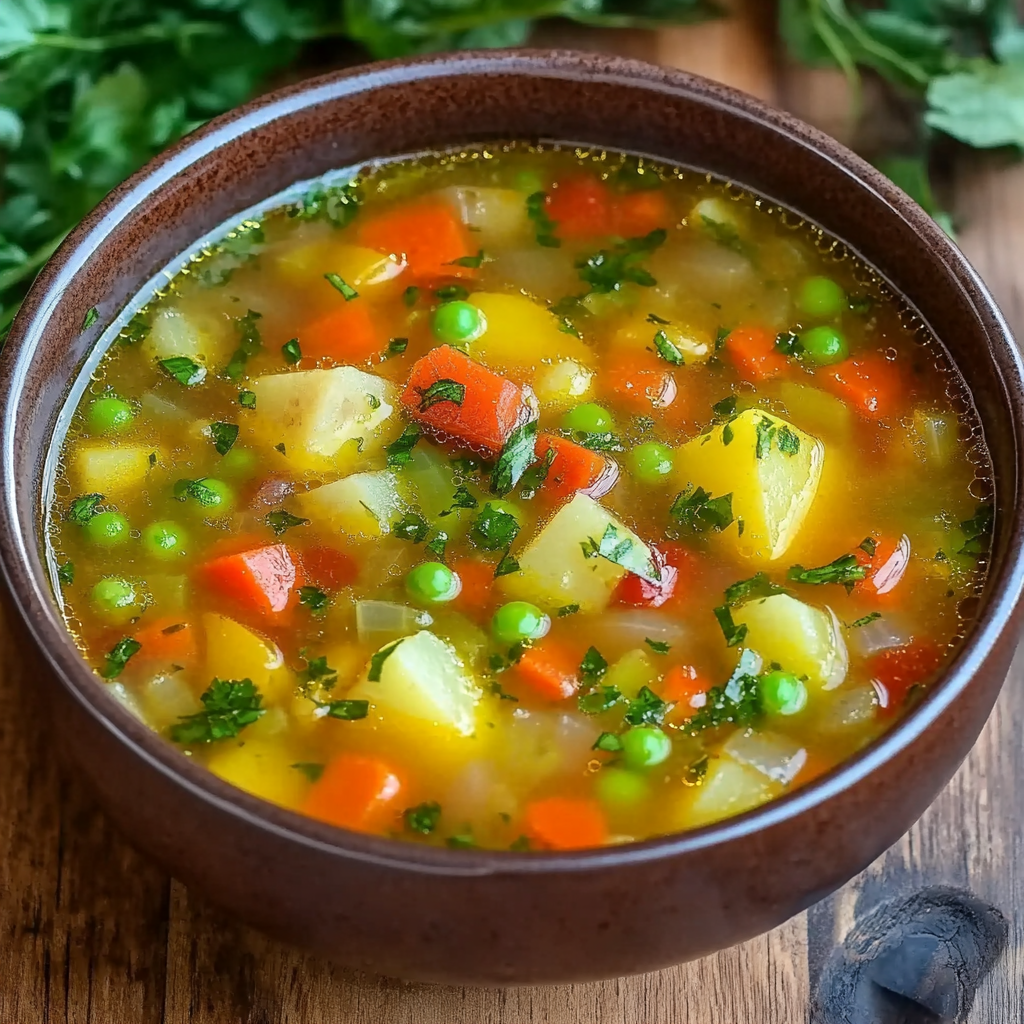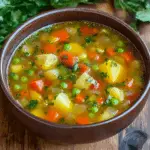When it comes to simple, satisfying meals, few dishes match the comforting appeal of a homemade vegetable soup. Whether you need a healthy weeknight dinner or a cozy meal prep option, vegetable soup recipes offer versatility, flavor, and nutrition. They are easy to prepare, require minimal cleanup, and can be adapted to suit seasonal produce or pantry staples you already have.
Unlike canned versions, making soup from scratch allows you to control the ingredients and boost the nutritional value. Many people wonder if frozen vegetables are a good choice. The answer is yes—frozen vegetables retain most of their nutrients and are incredibly convenient. Plus, by using a quality vegetable broth and seasoning it well with herbs like basil, oregano, and thyme, you can enhance the depth of flavor in every spoonful. For even more hearty, healthy ideas, you can check out these hearty plant-based recipes that feature vegetables in creative ways.
Additionally, cooking soup in a slow cooker makes the process even easier. You can set it up in the morning and come home to a warm, aromatic meal. If you’re interested in expanding your repertoire beyond vegetable soups, you might also explore comforting winter soups perfect for cold evenings. Today, we’re focusing on how to make a meatless vegetable soup that’s rich in flavor, easy to customize, and perfect for meal prep.
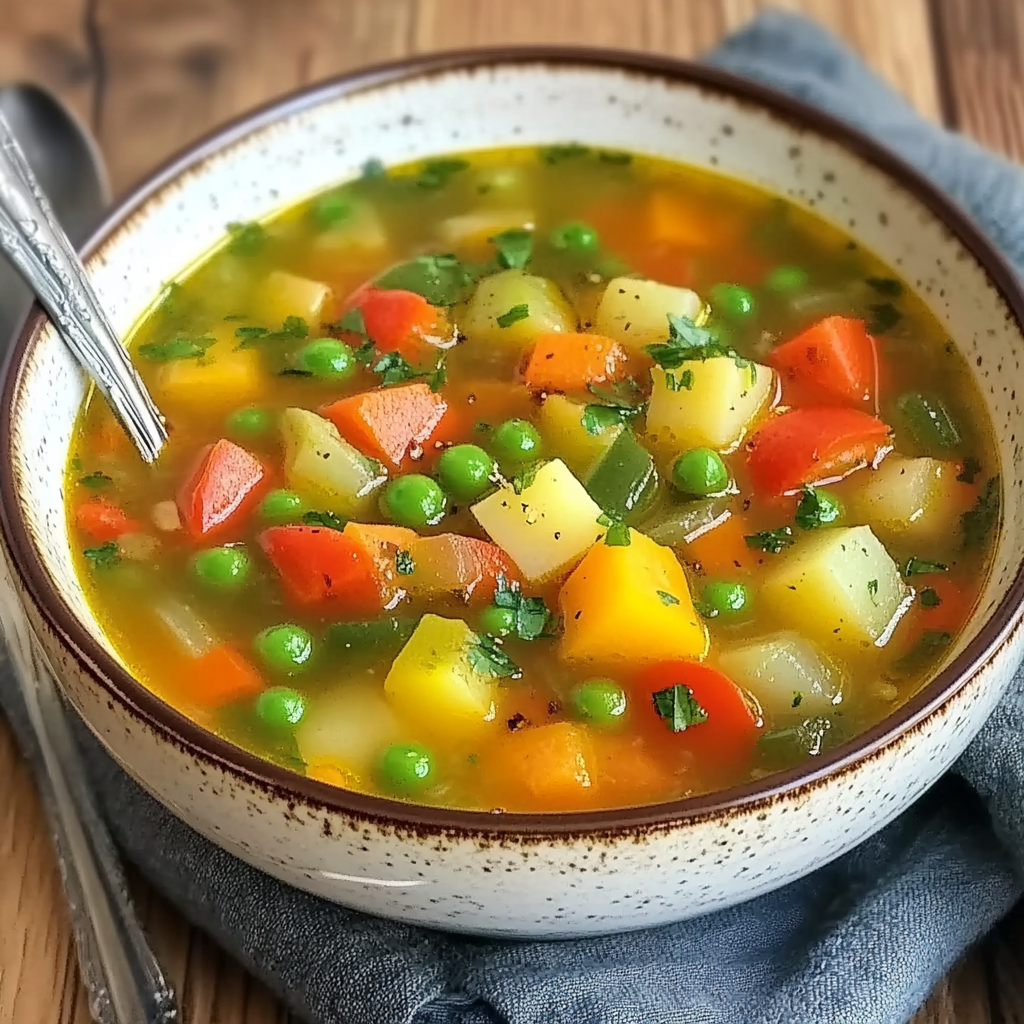
Why Choose a Meatless Vegetable Soup?
Choosing a meatless vegetable soup for your meals is more than just a healthy decision; it’s also a sustainable and budget-friendly choice. A plant-based soup is naturally low in saturated fat, packed with fiber, and abundant in essential vitamins and minerals. According to the health benefits of a vegetarian diet, reducing meat consumption can contribute to a lower risk of heart disease, diabetes, and certain cancers.
Moreover, preparing a vegetable soup recipe at home ensures you’re using whole, natural ingredients without any added preservatives or excessive sodium often found in store-bought options. When paired with other nutrient-rich dishes from these meal prep ideas for busy nights, you can create balanced meals that are both delicious and nourishing. Choosing homemade options empowers you to customize flavors, textures, and even nutritional profiles based on your personal needs.
Some compelling reasons to choose a meatless vegetable soup include:
-
Affordability: Vegetables, especially when in season or frozen, are inexpensive and easily accessible.
-
Versatility: You can swap ingredients based on availability, seasons, or personal preference.
-
Meal Prep Friendly: Soups store and freeze well, making them perfect for preparing in large batches.
-
Environmentally Friendly: Plant-based meals often have a lower environmental impact compared to meat-based dishes.
-
Dietary Inclusivity: It easily fits vegetarian, vegan, gluten-free, and even paleo diets.
By focusing on seasonal produce, you can enjoy a wide array of textures and flavors. Referencing the list of common vegetables can inspire creative combinations that keep your soup exciting and flavorful all year round.
Key Ingredients for the Best Vegetable Soup
Crafting the best vegetable soup begins with selecting the right combination of ingredients. The foundation of any flavorful soup lies in its vegetable broth, which serves as the base and should be rich, aromatic, and preferably low in sodium to allow for better seasoning control. You can learn more about its composition and variations in this vegetable broth basics guide. Whether homemade or store-bought, a good broth enhances every element of your soup.
Another critical consideration is the type of vegetables you use. While fresh produce is ideal for texture and flavor, frozen vegetables are a convenient, time-saving alternative that still offers high nutritional value. The key is choosing vegetables with complementary cook times. This is particularly helpful when referencing vegan soup inspiration that embraces both convenience and nutrition in everyday meals.
Core ingredients that form a flavorful, hearty base include:
-
Onions and garlic: Aromatics that build deep flavor.
-
Carrots and celery: Classic soup vegetables that add sweetness and texture.
-
Zucchini and green beans: Seasonal options that enhance color and variety.
-
Spinach, peas, and corn: Added at the end for freshness and vibrant color.
-
Canned diced tomatoes: Introduce acidity and body to the broth.
Don’t forget to season well. Herbs like dried basil, oregano, and thyme create a layered, herby depth, especially when added early in the cooking process. Salt and pepper bring it all together, ensuring each spoonful is balanced and flavorful.
Step-by-Step Instructions for Stove-Top Vegetable Soup
Making homemade vegetable soup on the stovetop is straightforward and rewarding. With a few simple steps, you can create a hearty meal full of flavor and nutrition. Start by heating olive oil in a large pot. Sauté diced onion until translucent, then add garlic, carrots, and celery, allowing the vegetables to soften slightly. This foundational step is essential for developing rich flavor.
Next, stir in the zucchini and green beans, cooking for a couple of minutes to enhance their natural sweetness. Then pour in the diced tomatoes, complete with their juices, and your vegetable broth. If you need ideas for enhancing flavor naturally, explore these hearty plant-based recipes, which show how layering simple ingredients can create deep flavors.
Season the mixture with dried basil, oregano, thyme, salt, and pepper. Bring it all to a gentle boil, then reduce the heat to a simmer. Cover the pot and let it cook for about 20–25 minutes, allowing all the vegetables to tenderize and meld. For those looking for seasonal vegetable inspiration, the list of common vegetables can offer plenty of ideas to adapt this base recipe.
Finally, stir in the spinach, peas, and corn in the last five minutes of cooking. These quick-cooking ingredients add vibrant color and a final burst of flavor to your finished soup.
Making Vegetable Soup in a Crock Pot (Slow Cooker Instructions)
Preparing vegetable soup in a crock pot simplifies the process even more, making it ideal for busy days. Using a slow cooker allows for slow, gentle cooking that intensifies flavors over time without much hands-on attention.
To adapt the stovetop method for a slow cooker:
-
Layer ingredients carefully: Place tougher vegetables like carrots and celery on the bottom for even cooking.
-
Add broth and seasoning: Pour the broth over the vegetables and season with basil, oregano, thyme, salt, and pepper.
-
Cook low and slow: Set your crock pot to low for 6–8 hours or high for 3–4 hours.
Be sure to add delicate ingredients like spinach, peas, and corn during the last 30 minutes of cooking to preserve their texture and color. For more comforting winter soups, you can check these ideas here, which also adapt beautifully to slow cookers.
Using a crock pot not only saves time but also ensures a consistently tender and flavorful result every time. Perfect for busy weeknights or weekend meal prep.
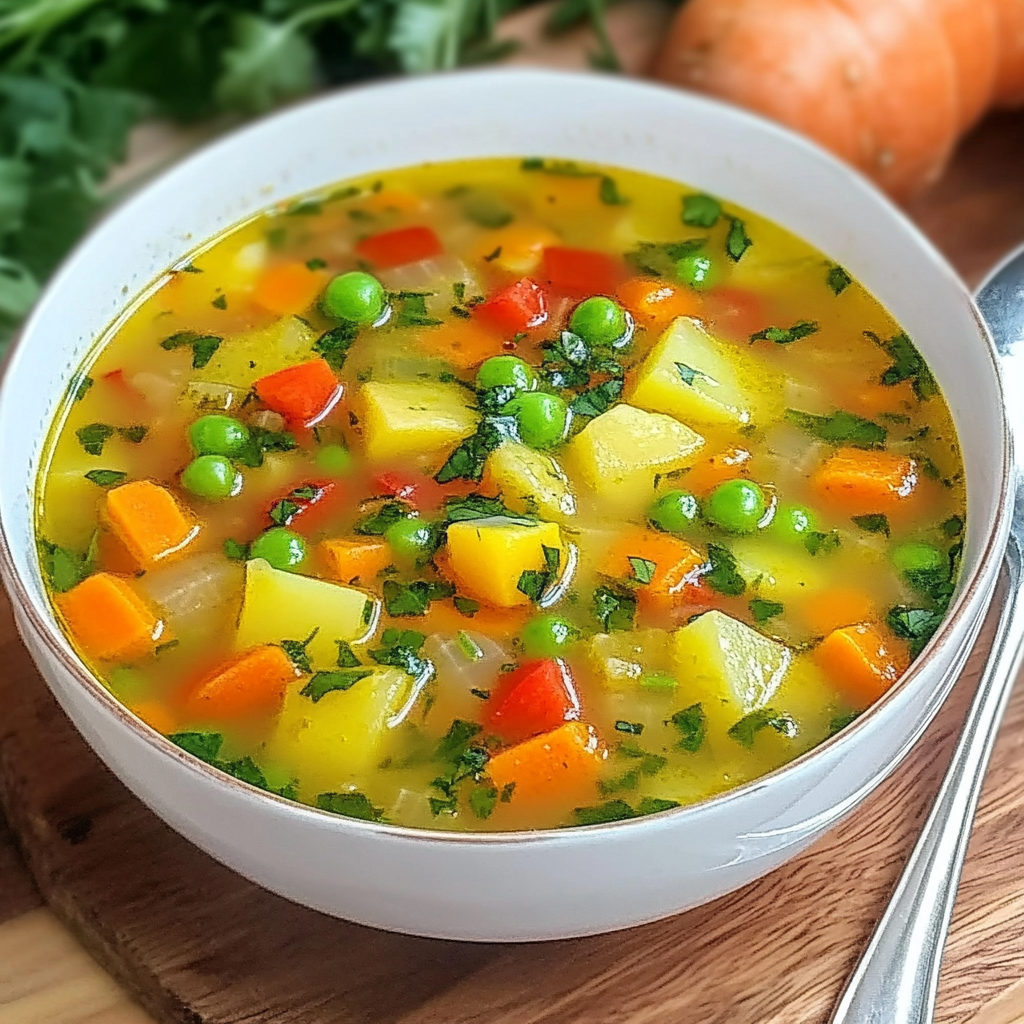
Tips for Customizing Your Vegetable Soup
One of the best aspects of homemade vegetable soup is how easily it can be customized to your preferences or what you have on hand. Using different ingredients can add new dimensions of flavor, texture, and nutrition.
Here are simple ways to customize your soup:
-
Swap vegetables seasonally: Try butternut squash in fall or asparagus in spring.
-
Add plant-based protein: Toss in chickpeas, white beans, or lentils for extra heartiness.
-
Flavor enhancements: A parmesan rind, splash of lemon juice, or drizzle of hot sauce can elevate the taste.
Using tips from meal prep ideas for busy nights can help you create different flavor profiles and avoid meal fatigue. If you want inspiration for keeping your soups hearty and satisfying, exploring vegan soup inspiration can provide creative combinations you might not have considered.
Adapting your vegetable soup based on your mood or pantry ensures that each batch remains exciting, nutritious, and perfectly suited to your tastes.
Storage, Freezing, and Reheating Tips
Properly storing and reheating your vegetable soup can make all the difference in maintaining its texture and flavor. Vegetable soups generally store exceptionally well, making them a perfect meal prep option.
Storage Tips:
-
Refrigeration: Store cooled soup in an airtight container for up to 5 days.
-
Freezing: Freeze in single-serving portions or larger batches for up to 3 months. Refer to these how to freeze soup tips to ensure the best texture upon reheating.
Reheating Tips:
-
Stovetop: Reheat gently over medium heat, stirring occasionally.
-
Microwave: Use medium power and stir between intervals to prevent uneven heating.
Freezing soups with delicate greens or potatoes can sometimes affect their texture, so add fresh spinach or herbs after reheating whenever possible. This technique ensures your soup tastes as fresh as the day it was made.
Serving Suggestions
A bowl of homemade vegetable soup can be a meal on its own or paired with complementary sides to make it even more satisfying.
Perfect pairings include:
-
Crusty bread: Great for dipping and soaking up the flavorful broth.
-
Fresh garden salad: Adds crunch and freshness to the meal.
-
Crackers or cornbread: Easy and comforting additions.
For an extra touch, sprinkle freshly grated parmesan cheese or chopped herbs like parsley over the top before serving. These simple additions enhance both the presentation and taste of your dish.
Nutritional Benefits of Homemade Vegetable Soup
One of the biggest advantages of preparing your own vegetable soup recipe is the nutritional control it offers. Homemade versions are naturally low in fat, high in fiber, and rich in essential vitamins and minerals.
According to the nutritional benefits of spinach, ingredients like spinach contribute iron, magnesium, and vitamin C to your soup, boosting its health value. Moreover, when comparing homemade soups to store-bought ones, you avoid excess sodium, preservatives, and artificial flavors.
Homemade vegetable soups support:
-
Digestive health thanks to high fiber content.
-
Immune function with plenty of vitamins and antioxidants.
-
Weight management because they are filling yet low in calories.
Building a habit of preparing your own soups can significantly improve your diet quality without sacrificing flavor or satisfaction.
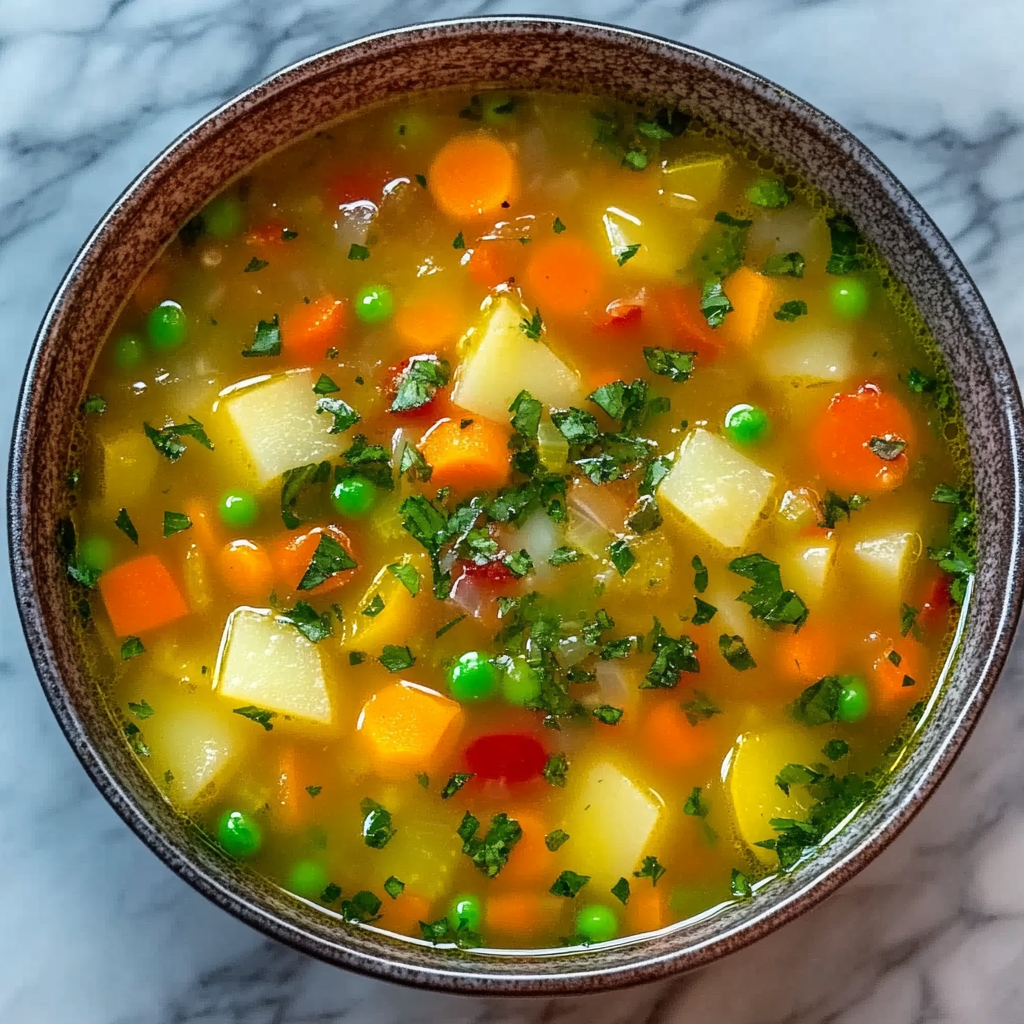
FAQs Section
Can I put frozen vegetables directly into soup?
Yes, you can add frozen vegetables directly into the soup without thawing. They are flash-frozen at peak ripeness and maintain their nutrients and flavor well.
What is the best seasoning for vegetable soup?
The best seasonings include dried basil, oregano, thyme, salt, and pepper. Fresh herbs like parsley or cilantro added at the end can brighten the flavors.
How do you keep vegetable soup from getting mushy?
To avoid mushy vegetables, add quicker-cooking ingredients like spinach, peas, and corn towards the end of the cooking time. Also, avoid overcooking tougher vegetables.
Can I make vegetable soup ahead of time?
Yes, vegetable soup is ideal for making ahead. Its flavors often improve after sitting for a few hours or overnight in the refrigerator.
Is homemade vegetable soup healthy?
Absolutely. Homemade vegetable soup is packed with vitamins, minerals, fiber, and antioxidants, making it a nutritious and low-calorie meal option.
PrintEasy Homemade Vegetable Soup Recipes for Crock Pot and More
A warm, hearty, and flavorful homemade vegetable soup that’s easy to prepare on the stovetop or in a crock pot. Made with wholesome ingredients like carrots, celery, zucchini, and spinach, this satisfying meatless soup is perfect for cozy weeknight dinners or healthy meal prep. Fresh herbs and a rich vegetable broth bring out vibrant flavors, while frozen vegetables add convenience without sacrificing nutrition.
- Author: Clara
Ingredients
- 2 tablespoons olive oil
- 1 onion, diced
- 3 cloves garlic, minced
- 3 carrots, peeled and sliced
- 2 celery stalks, sliced
- 1 zucchini, diced
- 1 cup green beans, trimmed and cut into 1-inch pieces
- 1 can (14.5 oz) diced tomatoes, with juice
- 6 cups vegetable broth
- 1 teaspoon dried basil
- 1 teaspoon dried oregano
- 1/2 teaspoon dried thyme
- Salt and pepper, to taste
- 1 1/2 cups baby spinach
- 1/2 cup frozen peas
- 1/2 cup corn kernels
Instructions
Heat the olive oil in a large pot over medium heat. Add the diced onion and cook until it becomes translucent.
Stir in the garlic, carrots, and celery, and sauté for about 5 minutes until the vegetables start to soften.
Add the zucchini and green beans, and cook for another 2-3 minutes.
Pour in the diced tomatoes with their juice and the vegetable broth.
Season with basil, oregano, thyme, salt, and pepper. Bring the soup to a boil.
Reduce the heat to a simmer, cover the pot, and cook for about 20-25 minutes until all vegetables are tender.
Stir in the spinach, peas, and corn. Cook for another 5 minutes until everything is heated through.
Taste and adjust seasoning if needed before serving.
Notes
-
Use seasonal vegetables: Adapt the recipe to what’s fresh for the best flavor and texture.
-
Broth matters: Choose a good quality, low-sodium vegetable broth to control the seasoning.
-
Don’t skip the sauté: Building flavor at the beginning makes a huge difference.
-
Freeze in portions: Ideal for quick meals anytime you need a healthy option.
-
Customize easily: Add beans, quinoa, or pasta to make it heartier if desired.
